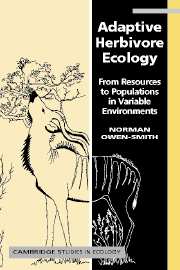Book contents
- Frontmatter
- Contents
- Acknowledgements
- Acronym and symbol conventions
- 1 Conceptual origins : variability in time and space
- 2 Consumer–resource models : theory and formulation
- 3 Resource abundance : intake response and time frames
- 4 Resource distribution : patch scales and depletion
- 5 Resource quality : nutritional gain and diet choice
- 6 Resource constraints : physiological capacities and costs
- 7 Resource allocation : growth, storage and reproduction
- 8 Resource production : regeneration and attrition
- 9 Resource competition : exploitation and density dependence
- 10 Resource-dependent mortality : nutrition, predation and demography
- 11 Habitat suitability : resource components and stocking densities
- 12 Resource partitioning : competition and coexistence
- 13 Population dynamics : resource basis for instability
- 14 An adaptive resource ecology : foundation and prospects
- References
- Index
14 - An adaptive resource ecology : foundation and prospects
Published online by Cambridge University Press: 04 February 2011
- Frontmatter
- Contents
- Acknowledgements
- Acronym and symbol conventions
- 1 Conceptual origins : variability in time and space
- 2 Consumer–resource models : theory and formulation
- 3 Resource abundance : intake response and time frames
- 4 Resource distribution : patch scales and depletion
- 5 Resource quality : nutritional gain and diet choice
- 6 Resource constraints : physiological capacities and costs
- 7 Resource allocation : growth, storage and reproduction
- 8 Resource production : regeneration and attrition
- 9 Resource competition : exploitation and density dependence
- 10 Resource-dependent mortality : nutrition, predation and demography
- 11 Habitat suitability : resource components and stocking densities
- 12 Resource partitioning : competition and coexistence
- 13 Population dynamics : resource basis for instability
- 14 An adaptive resource ecology : foundation and prospects
- References
- Index
Summary
In this concluding chapter, I review retrospectively the conceptual foundation established by preceding sections, and outline prospects for further developments of the resource-centred metaphysiological approach. I also look beyond the specific models developed for large mammalian herbivores in this book, to raise some general theoretical issues concerning the dynamics of consumer–resource systems. Thereby I introduce the vision of a broader Adaptive Resource Ecology.
Retrospective review
In starting this book, I set out to establish a conceptual framework for modelling herbivore–vegetation systems that would accommodate spatiotemporal variability in the resource base. The approach entailed integrating models of adaptive resource use by individual herbivores into a metaphysiological formulation of population dynamics. The basic principle was not to develop an elaborate, multi-level simulation, but rather to incorporate the functional outcome of lower-level processes, such as adaptive behaviour, into higher-level dynamics.
The starting foundation was Caughley's (1976a) modification of the classical Lotka–Volterra equations for herbivore–vegetation systems. I extended Caughley's analysis by recognizing how variation in food quality could cause the consumer gain function to deviate from the intake (‘functional’) response to changing resource abundance. Furthermore, I specified mortality losses as being non-linearly dependent on nutritional gains (following Getz 1991, 1993). In addition, I allowed for physiological expenditures as an independent biomass loss. The GMM label captured mnemonically the basic processes governing consumer biomass dynamics, at all levels from individuals to populations: Growth, Metabolism and Mortality.
- Type
- Chapter
- Information
- Adaptive Herbivore EcologyFrom Resources to Populations in Variable Environments, pp. 335 - 345Publisher: Cambridge University PressPrint publication year: 2002



